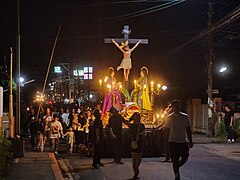This article may require copy editing for grammar, style, cohesion, tone, or spelling. (December 2023) |
| Holy Week in the Philippines | |
|---|---|
 | |
| Also called |
|
| Observed by | |
| Type | Religious, Historical, Cultural |
| Significance | Commemoration of the Passion, Death and Resurrection of Jesus |
| Observances | Processions, religious services |
| Begins | Palm Sunday |
| Ends | Easter Sunday |
| Frequency | Annual |
Holy Week (Filipino: Mahal na Araw; Spanish: Semana Santa) is a significant religious observance in the Philippines for the Catholic majority, the Iglesia Filipina Independiente or the Philippine Independent Church, and most Protestant groups. One of the few majority Christian countries in Asia, Catholics make up 78.8 percent of the country's population,[1] and the Church is one of the country's dominant sociopolitical forces.[2]
The solemn celebration begins on Friday of Sorrows turning to Palm Sunday and continues on through to Easter Sunday.[3] Many communities observe Spanish-influenced Catholic rituals such as processions, that have been syncretised with elements of precolonial beliefs. This is evident in some ritual practices not sanctioned by the universal Church and the many superstitions associated with the occasion.
The days of the Easter Triduum (Maundy Thursday until Black Saturday) are considered statutory holidays. During this period, many businesses are closed or operate on shorter hours. Local terrestrial television and most radio stations usually go off the air (for annual maintenance of broadcast equipment), while others (such as stations owned by various denominations) shorten broadcasting hours and feature Lenten drama specials, religious and inspirational programming. Holy Week celebrations also receive wide news coverage of various services and rites. International cable television channels distributed to the Philippines, however, continue to broadcast their normal programming, while channels dedicated to horse racing, cockfighting and similar niche programming go off-air during the Triduum.
Holy Week in the Philippines is also highly anticipated as one of the annual long weekends in the country.[4] Non-Catholics or non-practicing Catholics take this opportunity to go on vacations, resulting to a peak season in most Philippine tourist destinations.[5]
- ^ Yraola, Abigail Marie P. (February 22, 2023). "Catholics make up nearly 79% of Philippine population". BusinessWorld. Archived from the original on February 23, 2023. Retrieved April 8, 2023.
- ^ Peterson, William (Fall 2007). "Holy Week in the "Heart of the Philippines": Spirituality, Theatre, and Community in Marinduque's Moriones Festival". Asian Theatre Journal. 24 (2): 309–337. doi:10.1353/atj.2007.0039. JSTOR 27568417. S2CID 161092074.
- ^ Bueza, Michael (March 22, 2016). "Overview: Holy Week traditions in the Philippines". Rappler. Archived from the original on April 7, 2015. Retrieved April 30, 2019.
- ^ Sexton, Colleen A. (January 1, 2006). Philippines in Pictures. Twenty-First Century Books. p. 46. ISBN 978-0-8225-2677-3. Retrieved March 10, 2023.
- ^ Rood, Steven (June 15, 2019). The Philippines: What Everyone Needs to Know®. Oxford University Press. p. 149. ISBN 978-0-19-092060-9. Retrieved April 8, 2023.